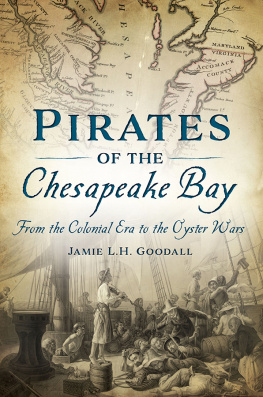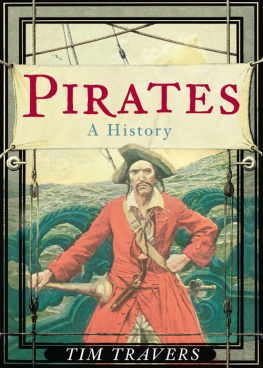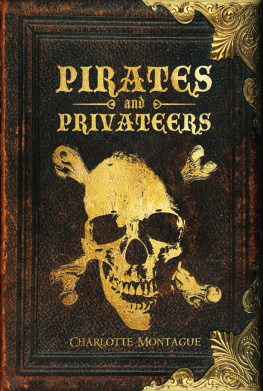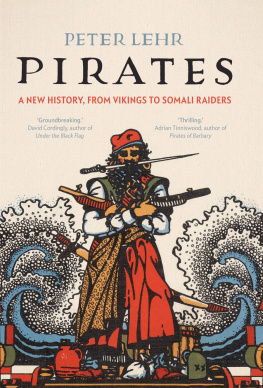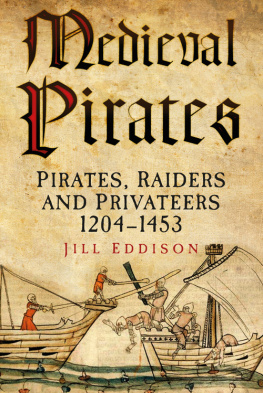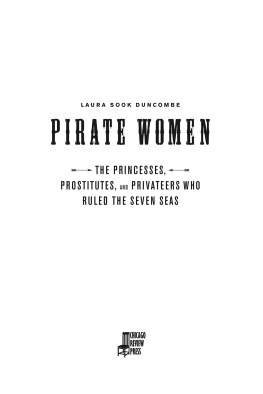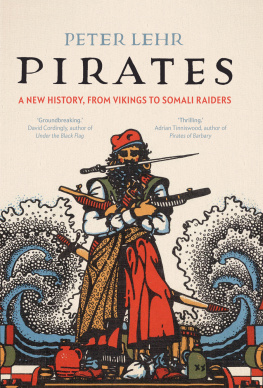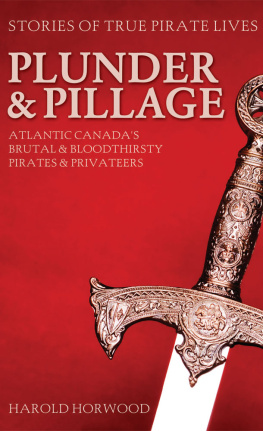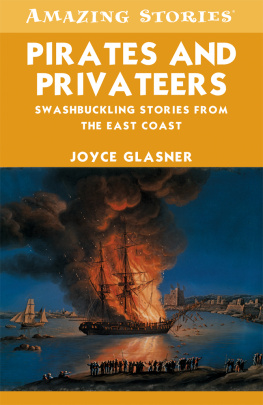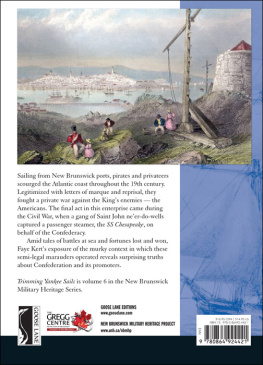Eddison - Medieval pirates : pirates, raiders and privateers 1204-1453
Here you can read online Eddison - Medieval pirates : pirates, raiders and privateers 1204-1453 full text of the book (entire story) in english for free. Download pdf and epub, get meaning, cover and reviews about this ebook. City: Ärmelkanal., Atlantic Ocean--English Channel., Stroud, year: 2013, publisher: History Press, genre: History. Description of the work, (preface) as well as reviews are available. Best literature library LitArk.com created for fans of good reading and offers a wide selection of genres:
Romance novel
Science fiction
Adventure
Detective
Science
History
Home and family
Prose
Art
Politics
Computer
Non-fiction
Religion
Business
Children
Humor
Choose a favorite category and find really read worthwhile books. Enjoy immersion in the world of imagination, feel the emotions of the characters or learn something new for yourself, make an fascinating discovery.

Medieval pirates : pirates, raiders and privateers 1204-1453: summary, description and annotation
We offer to read an annotation, description, summary or preface (depends on what the author of the book "Medieval pirates : pirates, raiders and privateers 1204-1453" wrote himself). If you haven't found the necessary information about the book — write in the comments, we will try to find it.
Eddison: author's other books
Who wrote Medieval pirates : pirates, raiders and privateers 1204-1453? Find out the surname, the name of the author of the book and a list of all author's works by series.
Medieval pirates : pirates, raiders and privateers 1204-1453 — read online for free the complete book (whole text) full work
Below is the text of the book, divided by pages. System saving the place of the last page read, allows you to conveniently read the book "Medieval pirates : pirates, raiders and privateers 1204-1453" online for free, without having to search again every time where you left off. Put a bookmark, and you can go to the page where you finished reading at any time.
Font size:
Interval:
Bookmark:

Merchant and pirate were for a long
period one and the same person.
Friedrich Nietzsche (18441900),
German classical scholar, philosopher and critic of culture
Cover illustration: Cogs in Action c. 1330. Cogs had a single square sail. Castles were added to give height. Here, the taller ship is winning the contest, while sailors falling overboard from the other indicate defeat. (BL Royal 10 E IV f.19. Published with permission of Bridgeman Art Library)
D r Joan Thirsk and Dr, later Professor, Richard Smith, did much to encourage and promote my interest in medieval history. Dr Mark Bailey provided further insight into the period and into its sources at summer courses at Madingley Hall, Cambridge. Dr Mark Gardiner, medieval archaeologist from whom I had already learnt a great deal, discussed this project in advance and made valuable comments on an early draft of this book.
The basic research was carried out in the Canterbury Cathedral Archives and in the Templeman Library at the University of Kent at Canterbury. Occasionally I also visited the East Sussex Record Office. In all of them, I was grateful for the efficiency and cheerfulness of the staff. Charlotte Deane, who also helped as a picture researcher, kindly provided reference material which was available in London but not in Kent. Towards the end, my cousin, Captain David Balston, Royal Navy Rtd, alerted me to the challenges of present-day piracy, and provided a lot of detailed information.
In addition, the ten years covered by this project saw great technological changes and expansion of horizons for research. In 2003 Dr G.R. Boynton of the Libraries at the University of Iowa pioneered the way by making the Calendar of the Patent Rolls available on the web, free of charge. More recently the Dictionary of National Biography and much other material also became available there, so that some research could be carried out at home.
Joanna Hitchcock, friend from our student days and former director of the University of Texas Press, has, as ever, provided enthusiastic support and offered much very helpful advice. The late Dottie Gray spurred me on through the early years. More recently, Jane Lushington read painstakingly through each chapter in turn and provided valuable comments.
Ever since we acquired our first personal computer some thirty years ago, my son James Eddison has updated the equipment and guided my use of various systems. Patiently, he saw all the material into the Dropbox which took it to The History Press. Lastly, he compiled the index. Minh Tran also took a hand, upgrading my equipment. Throughout this time my husband David has kept the home fires burning, giving me the freedom to follow other interests.
Without the help, support and expertise of all these people, in all their varied fields, the material could not have been assembled, nor the book written, and it certainly could have not reached the publisher. I am profoundly grateful to them all. The interpretation of the story is, however, entirely my own.
Jill Eddison
June 2013
Fair digital copies of my manuscript maps were made by Philip Stickler in the Cartography Unit, Department of Geography, University of Cambridge.
by Professor Richard Smith |
P irates left no official records. They were not in business to leave neat series of connected accounts for historians to assess several centuries later, and indeed it was probably that lack which explains why medieval pirates have escaped literary attention so far. As a result of the absence of systematic sources, the information for this book has had to be gathered from occasional, scattered, records found elsewhere. It has come from three distinct directions: the monastic chronicles; the official national records of government; and the large and varied bank of published, secondary, work.
The monastic chronicles are believed to have originated with Bede in the eighth century. The eleventh and twelfth centuries saw the foundation and flowering of an increasing number of religious houses, and by the thirteenth, chroniclers were busily recording not only the internal management of their own house and its estates, but were also interacting with local townsfolk and passing travellers to record the affairs of the wider world. They built up a picture of history, past and ongoing. They were, in fact, becoming the keepers of the nations memory.
One of the best informed and most frequently quoted of the chroniclers was Matthew Paris ( c . 120059), a monk who began by assisting Roger of Wendover, the chronicler of St Albans, from 1217 onwards, before succeeding him in 1236. He spent nearly all his life in that abbey, strategically well placed beside the Great North Road only 20 miles from London. Having a roving interest and remarkably broad understanding, he collected the latest news and opinions from travellers, messengers and from the royal court which was constantly on the move. He went further, and developed a personal relationship with both Henry III and his influential brother, Richard of Cornwall. Not one to conceal his own opinions, it is clear that Paris respected the king for his religion, but deprecated his inadequate political management: he openly criticised Henrys use of foreign relatives as his advisors. This exceptionally talented man illustrated his documents with easily recognisable pictures, and his maps (including one of Britain and another illustrating in a sequence of pictures the night-stops and the seas crossed on the route to the Holy Land) predated the advent of sophisticated, precise surveying techniques by some 300 years.
The Dissolution of the Monasteries in the late 1530s was a time of great upheaval which imperilled the survival of all these monastic documents. However, as the chronicles were recognised as such valuable collections of national history, and also because they were almost all conveniently written in books kept in libraries, separate from other documents, they were among the first to be rescued by the Tudor scholars. Matthew Parker, destined to be Elizabeths Archbishop of Canterbury (in 155975), made sure that many of them were transferred to college libraries and there they have survived. Ultimately, beginning in 1857, government funding was directed to meticulous editing of these documents by Victorian scholars, an operation which continued for fifty years. In all, 100 chronicles were transcribed, calendared (summarised) and printed in 253 volumes, mostly remaining in Latin but accompanied by lengthy introductions in English. Those volumes are now generally available on the shelves of the larger libraries and archive offices.
While the chronicles are indispensable, often as the only records of early events, they do have their limitations. Matthew Paris and the others, like modern newsmen, delighted in drama, hence their stories are likely to be exaggerated or biased and are by no means indisputable. Sometimes, where French and English accounts of the same occasion can be compared, they are scarcely recognisable. Some unsuccessful events were virtually ignored by the scribes on one or other side of the Channel. Memory is conveniently selective.
The Patent Rolls and the Close Rolls (and other series to a lesser extent), which were also calendared and printed, in English, towards the end of the nineteenth century, contain innumerable references to piracy, either complaints by foreign heads of state on behalf of their merchants in respect of losses to English pirates, or directions to various mariners not to intermeddle with the ships of others. Here, the problem is that these edicts were instructions, and there is no guarantee or, usually, evidence that the recipients carried them out. They may have simply amounted to wishful thinking. However, it was during a trawl through the Patent Rolls thirty years ago, following up another interest (historic sea floods) that this author was originally alerted to the intensity of complaints about piracy and their potential as a source of history.
Next pageFont size:
Interval:
Bookmark:
Similar books «Medieval pirates : pirates, raiders and privateers 1204-1453»
Look at similar books to Medieval pirates : pirates, raiders and privateers 1204-1453. We have selected literature similar in name and meaning in the hope of providing readers with more options to find new, interesting, not yet read works.
Discussion, reviews of the book Medieval pirates : pirates, raiders and privateers 1204-1453 and just readers' own opinions. Leave your comments, write what you think about the work, its meaning or the main characters. Specify what exactly you liked and what you didn't like, and why you think so.


